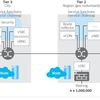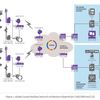By: Keith Allan, Director IP Mobile Core Product Strategy, Alcatel-Lucent
From original TechZine article
Can the virtualized evolved packet core (vEPC) be deployed today in large scale, LTE networks? Mobile network operators (MNOs) are increasingly convinced that the vEPC has become viable both financially and technically. And I think so, too, based upon the advances made over the past year that I’ll discuss in this blog.
Advancements in vEPC scaling and performance
Early in 2014, the vEPC proofs of concept and field trials of virtualized mobility management and gateway products were limited in both scale and performance. But as the year progressed, advancements in the design and architecture used network functions virtualization (NFV) tools and capabilities that greatly improved their capacity and performance.
- Control plane subscriber scaling – It is now possible to support up to millions of simultaneous attached users and hundreds of thousands of eNodeBs and small cells on a single virtualized mobility management entity (vMME) instance. This is comparable with today’s existing MMEs built on standard telecom hardware platforms.
- Data plane user capacity – Packet acceleration techniques have significantly increased capacity and performance of the virtualized serving and packet gateways (vSGW/vPGW). For example, Single Root – Input/Output Virtualization (SR-IOV) bypasses the hypervisor and enables virtual machines (VMs) to attach to the VNF (the vSGW/vPGW ) and share a single physical network interface card (NIC) that functions as multiple virtualized NICs.This greatly improves speed and increases capacity by reducing processing overhead.
These improvements, together with other software enhancements, such as the Data Plane Development Kit (DPDK), have the vSGW/vPGW approaching the capacity and performance of dedicated hardware platforms.
Converged NMS/VNF manager: The key to seamless vEPC network operations
A lot of progress has been made with enhancements to the ETSI Management and Orchestration (MANO) architecture. However, rather than having separate element management system (EMS) and VNF manager (VNFM) functions, there’s been a move to converge these functions since both are integral to managing the VNFs. (The EMS described by MANO includes both network and element management (NMS/EMS) functions).
By unifying the VNF manager and NMS functions, an MNO can seamlessly manage and orchestrate the vEPC. This makes it easy for an MNO to perform VNF lifecycle management functions from the same NMS that is used on a day-to-day basis for network operations.
When EMS and VNFM are converged:
- The creation of vEPC VNFs is simplified with templated configuration and automatic instantiation.
- The EMS functions provide collection of VNF related NFV Infrastructure performance measurement data
- Pre-configured threshold crossing conditions seamlessly alert VNF manager functions to either automatically take action or alert network operations. (This could be, for example, to dynamically scale out a VNF to provide more capacity to meet unforeseen demand.)
The traditional NMS Fault, Configuration, Accounting, Performance and Security (FCAPS) management function is now applicable to both the EPC VNFs and the physical network functions (PNF). This enables a common and consistent approach.
This also provides the topology and logical connectivity of the individual VNFs/PNFs and more advanced performance and SLA reporting. A single manager simplifies overall coordination and adaptation for configuration and event reporting between the virtualized infrastructure manager (VIM) and the NMS.
Troubleshooting is simplified because traditional NMS faults/events are correlated with VNF related events/faults. The VNFM provides lifecycle management and automates the self-healing of VNFs. It uses recipes to describe the vEPC VNF, its VNF components (underlying VM instances) and their interdependencies. Each VNF component has its own recipe, which includes a description of how to monitor, self-heal, and scale it.
With coordinated fault management and automated self-healing, the MNO’s operations team will have the visibility and intelligence to understand whether alarms are caused by normal maintenance activities or are indeed an emerging issue that they need to react to quickly. In addition, new advanced NMS approaches to network assurance visualization will speed problem assessment for both VNF and PNFs. These developments will also provide the VNF and network event data to support reporting and analysis.
When the VNFM and the NMS are combined into a single management functional instance, the management and orchestration of the vEPC VNF and integration of the vEPC into the existing OSS/BSS infrastructure is greatly simplified. This is because the VNFM/ NMS has complete knowledge and visibility of VNFs within the physical and virtual EPC network.
Is the vEPC ready for commercial deployment?
Based on the progress made in both the scalability and performance of the vEPC VNFs and the advances made in management and orchestration of the vEPC, 2015 will be the year for vEPC deployments to commence at some Tier 1 mobile operators. The momentum and confidence of mobile operators in NFV will make it a reality.
Alcatel-Lucent at Mobile World Congress
Alcatel-Lucent will have a large presence at Mobile World Congress in Barcelona. I will take part in a panel discussion on “Unifying Network IT and Telco IT” on Thursday, March 5th from 11.30 – 13.00.
We will also be demonstrating our vEPC at our booth. There you will be able to see the dynamic scaling of our Virtualized Mobile Gateway and the operational elegance of our NMS/VNFM system. I look forward to seeing you there and discussing how our vEPC solution can meet your NFV evolution plans.
Related Material
- Alcatel-Lucent virtualized Evolved Packet Core (vEPC) application note
- Alcatel-Lucent Mobile Meets Cloud webpage
- Alcatel-Lucent IP Mobile Core webpage
- Alcatel-Lucent CloudBand webpage
- Nuage Networks webpage
- Alcatel-Lucent collaborates with Korea’s KT to accelerate the shift to NFV press release
To contact the author or request additional information, please send an email to [email protected].












